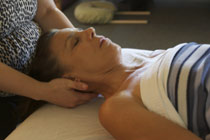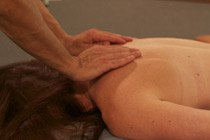Connective Tissue Massage
The History of Connective Tissue Massage
 The Connective Tissue Massage (CTM) technique was developed in 1928 by Elizabeth Dicke (1884-1952), a German physical therapist (Goats & Keir, 1991). In the late 1920s, She suffered from an infection of the blood vessels, which impeded the circulation of her right leg (Isler). After using stretching strokes on her back to relieve lumbosacral pain, she observed "a sensation of tingling and warmth" in her leg following the back treatment(Goats & Keir, 1991). She continued the stretches in her back and other areas and the circulation in her leg greatly improved as well as her kidney and liver problems (Isler). From then on, she started to research and develop this new style of healing (Isler).
The Connective Tissue Massage (CTM) technique was developed in 1928 by Elizabeth Dicke (1884-1952), a German physical therapist (Goats & Keir, 1991). In the late 1920s, She suffered from an infection of the blood vessels, which impeded the circulation of her right leg (Isler). After using stretching strokes on her back to relieve lumbosacral pain, she observed "a sensation of tingling and warmth" in her leg following the back treatment(Goats & Keir, 1991). She continued the stretches in her back and other areas and the circulation in her leg greatly improved as well as her kidney and liver problems (Isler). From then on, she started to research and develop this new style of healing (Isler).
Dicke's CTM techniques were later clinically verified by two medical doctors Professor Kohlrausch and Dr. Teirich-Laube and they confirmed the therapeutic value of CMT (Isler). CMT began to gaine recognition and popularity among the public.
What Is Connective Tissue Massage?
 Connective tissue massge is a massage technique dealing with superficial connective and subcutaneous tissues that are used for aiding the diagnosis and treatment of different pathologies (Goats & Keir, 1991).
Connective tissue massge is a massage technique dealing with superficial connective and subcutaneous tissues that are used for aiding the diagnosis and treatment of different pathologies (Goats & Keir, 1991).
The principles of CTM are based on the notion that "dysfunction of an internal organ" can be diagnosed by "the increased tone of superficial muscles, especially of the back", and "a changed character of interstitial fluid in the subsutaneous tissues" along with "hypensensitivity to touch" (Goats & Keir, 1991).
What Is Connective Tissue?
Connective tissue, also called fascia, refers to tissues that connect organs and systems and "surround, protect and support" all other structures in the body (Latz, 2001; Institute for Structural Integration).
"Gravity, injury, illness, emotional trauma", or stresses can all affect fascia and lead to discomfort, stiffness, reduced felexibility or pain in the body (Institute for Structural Integration). Connective Tissue Massage thus manipulates facsica by lengthening and opening it (Howe) to normalize tissues and provide treatment for those symptoms (Natural Therapy Pages;Institute for Structural Integration).
John Latz's Five Principles of CTM Body Mechanics
The following are the basic five principles, developed by John Latz, for affecting fascia in an optimal way.
1. "Leaning controlled body weight into the client" (Latz, 2001). This application ensures "contact with the appropriate layer of fascial resistance" and therefore is painless for the clinet (Latz, 2003). By utilizing the force of gravity, therapists can save muscular efforts on their part (Latz, 2003).
2. "Maintaining alighnment". Alignment refers to "the vertical line" which "runs from the sole of the foot through the ankle, knee, hip, shoulder, ear and top of the head" (Latz, 2003). Maintaining the line is important for keeping the controlled leaning effective (Latz, 2003).
3. "Movement through the alignment" (Latz, 2001). The movement is an extension of the alighment (Latz, 2003). When moving with the alighment, lengthening in a vertical direction through the bottom of the feet and out of the top of head, and extending through arms make your body "bigger and longer" and expand your own fascia in all directions as well. This can continually lead to the lengthening and expanding of the client's fascia (Latz, 2003).
4. "Using oblique angles of contact" (Latz, 2001). Fascia lies in broad and continuous planes in the body (Latz, 2003). An oblique angle of touch is needed in order to lengthen the broad sheet, which "takes the downward thrust out of the touch and puts in a more forward, stretching movement" (Latz, 2003).
5. "Contacting with soft and relaxed hands and body" (Latz, 2001). As a therapist, your relaxation during the session ensures noninvasiveness of the manipulation and brings the relaxation in your client (Latz, 2003). This can enhance proprioceptive feelings and make therapy more effective (Latz, 2003).
The five principles are interrelated and should be used as a entirety (Latz, 2003).
More information on the five principles of CTM body mechanics
Jennifer Greenwood is a Connective Tissue Massage instructor at Florida School of Massage, Gainesville, Florida, who has about 15 years of teaching experience in Connective Tissue Massage. In this video she talks about Connective Tissue Massage and the difference between Connective Tissue Massage and Deep Tissue Massage.
Health Benefits
 Connective Tissue Massage has physiological effects on the body both locally and generally (Goats & Keir, 1991). Locally, CTM helps the healing of subacute or chronic inflammation and reduce pain by eliminating nocigenic chemicals from tissues on the manipulation areas (Goats & Keir, 1991). CTM also affects the general body physiologically by benefiting the deep tissue distant from the superficial stimulation area along with an increase of flood flow and a pain reduction (Goats & Keir, 1991).
Connective Tissue Massage has physiological effects on the body both locally and generally (Goats & Keir, 1991). Locally, CTM helps the healing of subacute or chronic inflammation and reduce pain by eliminating nocigenic chemicals from tissues on the manipulation areas (Goats & Keir, 1991). CTM also affects the general body physiologically by benefiting the deep tissue distant from the superficial stimulation area along with an increase of flood flow and a pain reduction (Goats & Keir, 1991).
Specifically, CTM relieves chronic tension, increases mobility and flexibility, improves posture and enhances self-awareness (Hunter). It's also used in preventing and recovering from various injuries by relieving fascia strain and tension around joints (Hunter). Additionally, it's helpful for alleviating chronic symptoms and neuromusculoskeletal disorders such as fibromyalgia, arthritis, tendonitis, and sciatica (Institute for Structural Integration; Hunter).
